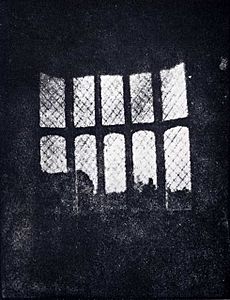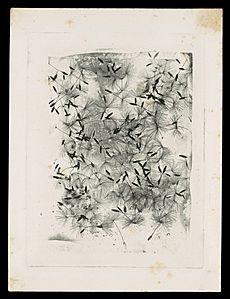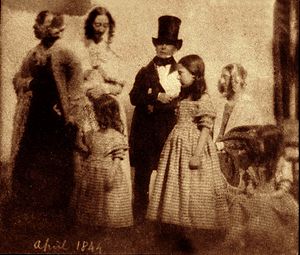Henry Fox Talbot facts for kids
Quick facts for kids
William Henry Fox Talbot
|
|
|---|---|

William Henry Fox Talbot, by John Moffat, 1864.
|
|
| Born | 11 February 1800 Melbury, Dorset, England
|
| Died | 17 September 1877 (aged 77) Lacock, Wiltshire, England
|
| Occupation | Scientist and inventor |
| Known for | Pioneering photography |
| Spouse(s) | Constance Talbot |
| Children | Ela (1835–1893) Rosamond (1837–1906) Matilda (1839–1927) Charles (1842–1916) |
| Parent(s) | William Davenport Talbot Elisabeth Fox Strangways |
| Awards | Royal Medal (1838) Rumford Medal (1842) |
William Henry Fox Talbot (1800–1877) was an English scientist and inventor. He was a pioneer in photography. He created the "salted paper" and "calotype" processes. These were early ways to make photographs. His work helped lead to modern photography.
In the 1840s, he also developed ways to print photos using machines. This led to the "photoglyphic engraving" process. It was an early form of "photogravure," which is a way to print high-quality images. Talbot also held a patent that affected how early photography developed in Britain. He was a talented photographer himself. He helped make photography an art form. He published a famous book called The Pencil of Nature. It had original photos made using his processes. He also took important early photos of places like Oxford and Paris.
Talbot was a very smart person who knew a lot about many subjects. He was elected to the Royal Society in 1831. This was because of his work in mathematics. He also studied optics (how light works), chemistry, and electricity. He even studied etymology (the history of words) and ancient history. He helped to understand cuneiform, an ancient writing system.
Contents
Early Life and Education
William Henry Fox Talbot was born in Melbury House in Dorset, England. He was the only child of William Davenport Talbot and Lady Elisabeth Fox Strangways. His governess, Agnes Porter, also taught his mother.
Talbot went to school at Harrow School and Trinity College, Cambridge. He won a prize for Classics in 1820. In 1821, he graduated with a strong math degree. From 1822 to 1872, he shared many papers with the Royal Society. Many of these papers were about math.
He also started studying light and how it works. This research later helped him invent photography. He wrote papers on "Coloured Flame" and "Monochromatic Light." He also wrote about how chemicals change color.
Inventing Photography

Talbot invented a way to make photographs that would last. This was the first process made available to the public. However, it was not the very first photographic process ever invented.
In January 1839, Louis Daguerre announced his invention, the daguerreotype. Talbot then said he had started his own experiments in 1834. On January 25, 1839, Talbot showed some of his paper photographs from 1835. He quickly shared details of his process with the Royal Society. Daguerre did not share details of his process until August. It soon became clear that their methods were very different.
Talbot's first process was called "salted paper" or "photogenic drawing." He used writing paper soaked in a weak salt solution. Then, he brushed one side with a strong silver nitrate solution. This created a coating of silver chloride. This coating was very sensitive to light. It would get darker when exposed to light.
This was a "printing out" process. This means the paper had to stay in the light until it was dark enough. For camera pictures, this could take an hour or two. Earlier inventors could not stop their photos from getting completely dark in daylight. Talbot found ways to make his photos stable. This meant they would not get darker after being made. He could then use the negative image from the camera to print many positive copies.
The Calotype Process
The "calotype" was an improved version of Talbot's earlier process. It was also called the "talbotype." This process used a different silver salt, silver iodide. It also used a special liquid called a "developing agent." This agent helped to bring out a hidden, or "latent," image on the paper.
This change greatly reduced the time needed to take a picture. In bright sunlight, it only took a minute or two. The calotype negative was see-through. This meant you could make many positive prints from one negative. You just placed the negative on another sheet of paper and exposed it to light.
Daguerreotypes were direct positives. You could only make copies by taking another picture of the original. However, calotypes were not as sharp as daguerreotypes. This was because the paper fibers in the negative could blur the image a little.
Talbot announced his calotype process in 1841. He allowed Henry Collen to be the first professional calotypist. Famous photographers like Hill & Adamson also used the process. In 1842, Talbot received the Rumford Medal for his photography work.
In 1852, Talbot found that gelatine treated with a chemical called potassium dichromate became less soluble when exposed to light. This discovery was important for later printing methods. It is still used today in some types of holography.
Talbot later focused on ways to print photos using machines. This made it easier and cheaper to make many copies of photos. It also helped make photos last longer. He created the "photoglyphic engraving" process. Others later improved this into the "photogravure" process.
Thomas Moore and the Talbot Family
Talbot was friends with the famous Irish poet Thomas Moore. In April 1844, Talbot took a calotype photo of Moore visiting his home. The photo shows Moore with members of Talbot's family.
Talbot's half-sister, Henrietta Horatia Fielding, is standing to his left. Eliza Frayland, the nursemaid, is on the far left. She started working for the family when Charles Henry Talbot was born in 1842. In the front are Talbot's children: Matilda Caroline (age 5), Ela Theresa (age 9), and Rosamond Constance Talbot (age 7). The woman on the right might be Moore's wife, Bessy.
Moore was very interested in Talbot's early photos. Talbot even took pictures of Moore's handwritten poems. He thought about including them in his book, The Pencil of Nature.
Light and Science Studies

Talbot was one of the first scientists to study how light breaks into different colors, called spectral analysis. He showed that each chemical element has a unique spectrum. This means you can identify elements by looking at their light. This method became very important for studying light from distant stars. It helps scientists figure out what stars are made of.
He also studied how light waves move in certain ways, called polarization of light. He used special crystals like tourmaline. He also helped design and use the polarizing microscope. Geologists still use this microscope to study rocks and minerals.

Talbot allowed his calotype process to be used freely for science. He published the first known photomicrograph of a mineral crystal. A photomicrograph is a photograph taken through a microscope. Another photo shows insect wings seen through a "solar microscope." He and others developed this microscope to project images of tiny objects onto a large screen using sunlight. These large images could then be photographed.
Talbot was very interested in using his calotype method to record nature. He photographed plants, buildings, and landscapes. He knew that the light we see is only a small part of all light. He also knew that powerful, invisible light beyond violet could cause chemical changes. We now call this ultraviolet radiation.
Other Activities

Talbot was also involved in politics. He supported the Whig politicians. He was a Member of Parliament for Chippenham from 1832 to 1835. He also held the position of High Sheriff of Wiltshire in 1840.
Besides his science work, Talbot spent a lot of time on archaeology. For 20 years, he studied Assyriology. This is the study of the history and culture of Mesopotamia (modern-day Iraq). He was one of the first people to understand the cuneiform writing from Nineveh. He wrote books like Hermes and Illustrations of the Antiquity of the Book of Genesis. He also wrote English Etymologies about the history of English words.
Works
- The Pencil of Nature (1844–46)
- Sun pictures in Scotland (1845)
- Loch Katrine (around 1845)
Posthumous Recognition
In 1966, William Henry Fox Talbot was added to the International Photography Hall of Fame and Museum.
|
See also
 In Spanish: William Fox Talbot para niños
In Spanish: William Fox Talbot para niños





